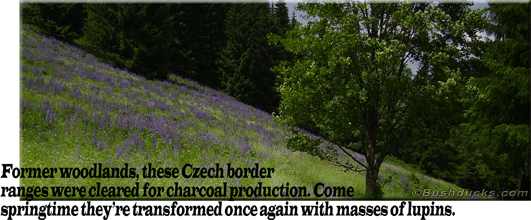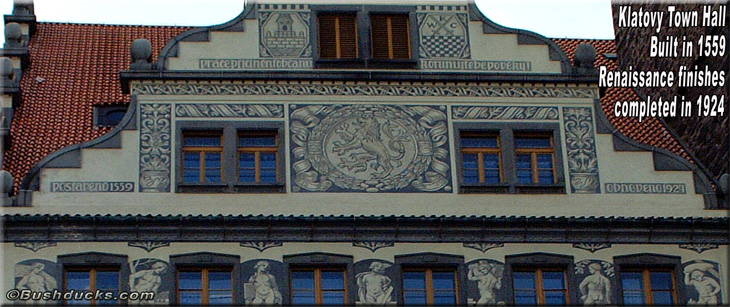|
The words conjure up visions of gaunt-cheeked poets drinking absinthe in garrets, waxen candles waiting to be lit, windows open to catch the last slanting rays of the sun. Or wild-haired gypsy girls dancing and twirling to the compulsive beat of drum and tambourine. Of ghosts and creatures that live in dark pine forests.
Bohemia: wild, remote, mysterious, the edge of the unknown.
The country's history, like much of middle Europe, is a bloody grind of war, occupied territory, and shifting boundaries. The independent Czechoslovakia was created in 1918, at the end of World War I. World War II saw the country annexed by Hitler and his German troops in his ongoing march across Europe. Many of the border towns in Bohemia were liberated by American troops in 1945, and still bear plaques and memorials with grateful wording.
But even after the World Wars, things were difficult for the Czech people. A Communist government was elected in 1946, and continued up until the Velvet Revolution of 1989--the peaceful revolution that quietly accomplished so much. In the Communist era, free speech and travel were severely restricted, both in and out of the state. This, after all, is the country that Martina Navratilova, the great women's tennis player, defected from for the United States in 1975.
In 1993, Czechoslovakia split into the Czech Republic, and Slovakia. Both countries joined the EU in 1994, although they have yet to adopt the Euro as their currency, still retaining the Crown.
Unlike much of western Europe, where you can drive from country to country, twisting in and out on small roads and villages with no border control, there's still a passport control into the Czech Republic. In addition, many of the smaller roads that show crossing points are closed to vehicle traffic. You can freely meander across on foot for a drink in the local restaurace in the village across the border, but for vehicle entry you have to go to the customs points found on the major roads. With an EU passport, you'll be on your way in under a minute. Likewise, Australians, Americans, and Canadians don't need visas for stays of up to 90 days.
Once across the border, you're in another world. Gas prices drop, and beer is cheaper than coffee. Czech beer--some of the best in the world--is often the same price as a glass of mineral water. About US$1 at time of writing. America's most well-known beer, Budweiser, originated here in the Czech Republic, in the town of Ceske Budejovice, and you can buy a beer called "Budvar" in most places. It bares little resemblance to the insipid American brew; Czech Bud is as full-flavored as any beer you've ever tasted. Be aware however, that there is a zero alcohol policy for drivers in the Czech Republic.
English isn't widely spoken outside of the major cities. The unofficial second language after Czech is German, which is common. But, as in most places, you can get by on a smile, sign language and the liberal use of Dękuji (Dek-wy) which means "thank you!" in Czech.
If you've crossed from southern Germany or Austria, you're in southern Bohemia. This immediate border area formed an important part of the Iron Curtain in the 20th century, and the inhabitants were moved out of the region. This lack of population ensured the landscape remained relatively undeveloped, and natural for many years, during a time when much of Europe was changing.
The landscape is somewhat tamed today-mainly through the infrastructure for tourism--but it still has an uncanny beauty. In the southern part of Bohemia, lying along the border where Germany, Austria, and the Czech Republic meet, is the Sumava National Park. It's the mountainous part of the country, away from the fertile plains of Prague; here the hills rise up in undulating lines and ridges. Much of the park is covered by spruce, fir, and beech forest; the natural vegetation of the region, interspersed with meadows where the forest was cleared by charcoal burners to fuel the industrial furnaces of the lowlands. These meadows complement the forest scenery, and in spring and early summer are resplendent with wildflowers, predominantly purple lupin. On the plateau are small, peaty lakes and wetlands, some of the most undisturbed in Europe. While you'll see no large wildlife--hunted to extinction for food in the last century--there's plenty of birdlife, including many birds of prey.  A worthwhile drive, which takes you through the heart of the National Park, is to take the smaller roads that lead off from Nyrsko. You can follow these good paved roads that follow ridgelines through the forest for miles, through the firs and spruce and past the sloping meadows of long grass ablaze with purple lupins. Bees buzz lazily around the flowers, and the road takes a smaller, more intimate quality. Fields follow the contours, and in summer, small haystacks dot the fields in haphazard stacks. Most of the small fields are still cut by hand, by a man or woman slowly (and carefully!) swinging a scythe. Instead of fences, the field boundaries are marked by the stream, or the crease of a hill, or a stand of trees. As well as being practical, for the tourer, the landscape has an open, unfettered quality that draws the eye on and on.
Catholicism dominates among the surviving organized religions, and there are many roadside shrines and churches that have survived the disinterest of the Communist regime. You'll see them dreaming in the long grass by the roadside: a small stone or concrete housing, containing a simple statue and maybe an offering of wildflowers. As beautiful as these forest roads are, you're still limited by being in a vehicle. The map shows tantalizing single gray lines leading off to a remote church, or to the border, or simply to nowhere. But on the ground, most of these roads aren't open to vehicle travelers. They're designated "Access Only" which means you and I can't drive down these meandering paths into the forest.
The large numbers of refreshment stops and accommodation choices make this region ideal for exploring at a slower pace. Look out for penzions, the Bed and Breakfasts of the region, or as it's written in German: zimmer frei, literally "vacant room". Here you'll get a clean, simple room and a hearty breakfast; usually bread, meat, cheese and coffee. But the Czech Republic isn't all about rural life. Much of the joy of the country is in the towns and villages. Here, the buildings are a maze of bulbous towers, church spires, and red tiled roofs. Narrow laneways and cobbled streets beckon exploring feet. But the most visually appealing style is one that makes a unique and beautiful facade out of little more than concrete and paint. Many of the buildings are symphonies of color; their flat white faces adorned with complex and beautiful patterns of faux brickwork, and complex murals. There are works of art, on many of the town buildings, even in the smallest of villages. Many of the towns are built around a large square, such as Klatovy, a royal town established in 1260. Here, we drank strong, dark coffee on a deck overlooking the main historic features of the town: The Black Tower, built between 1547 and 1559 to a height of 81 meters, the ornate Baroque Jesuit Church of the Immaculate Conception of the Virgin Mary and Saint Ignatius, with its rich decorative facade and the Baroque Pharmacy, now a unique museum, registered with UNESCO.
 After coffee, we visited the catacombs deep underneath the church. Here, preserved for eternity, are thirty bodies, members of the Jesuit order and important town dignitaries. Dating back to the 1670s, these blackened bodies repose in the chill of the underground crypt. Nowadays, they rest in glass-topped coffins, open to the gaze of the curious. We camped for two nights in a campground on the shores of Lipno Lake just outside of the small village of Cerná v Pošumaví. The gentle breeze from the lake carried away the daytime heat, Our fellow campers were mainly Dutch, and a few Germans. We sat and watched a fisherman casting and recasting and shared his excitement when he got a bite. A huge bite! The carp he pulled in had to have weighed five or six pounds, a good, fat, healthy fish. He offered it to us, explaining in broken English that he had a freezer full of them back in the Netherlands. Regretfully, we declined, saying that in Australia, these fish aren't considered good eating, being so full of bones, and besides, it was so big we had nothing to cook it on!
The lakeside campground allowed us to spend a day exploring the historic town of Ceský Krumlov, an extremely well-preserved town listed with UNESCO as a World Heritage Site . Within its walls we heard many different accents and languages, a testament to its deserved popularity as a destination. It is set in a valley, encased within a meander on the Vltava River, and our first sight of the town was from the hillside overlooking the red tile roofs and the dominant old castle with its six-story tower. The old town is for pedestrians only, so parking the Discovery in one of the parking areas outside the town walls, we walked in underneath the graceful arches of the Cloak Bridge, which spans the moat on the western side of the castle. And what a castle! The original gothic castle was rebuilt as a Renaissance Chateau in the 16th century, and from the first moment you wander underneath the towering Cloak Bridge to climb high above the city you're hooked. You can wander freely through the castle, through twisting, cobbled courtyards, and out onto hidden balconies, some barely big enough for two people, that boast a bird's eye view of the town.
Inside the town, we wandered for an afternoon, down the narrow cobbled streets, stopping every so often for another Czech beer or strong coffee, or to watch the canoeists and rafters shooting the man-made rapids on the river, a popular summer pastime. It's a one-way trip too; the rafting company will pick you up downstream and ferry you back to your starting point so you don't have to fight the currents (or surfeit of good food and drink) to get back to your starting place. Getting peckish, we ducked into an old restaurant overlooking the river. The U dwau Maryi restaurant prides itself on serving traditional Bohemian food. Here, we chose the Bohemian Feast, and were served huge portions of smoked meats, chicken, rabbit, and the many grains that the peasants ate: millet, peas, lentils, plus cabbage soup and of course heavy, delicious potato dumplings. Our feast set us back very few Crowns, and we felt we were eating as close to real Bohemian food as we had seen. The restaurant atmosphere lives up to the food, as it used recycled timbers and features from old buildings in the region to line its walls and create a unique atmosphere. Our long-haired, ear ringed waiter spoke English, German, and Czech with ease, and ensured our experience was a memorable one. It was with reluctance, that we took our leave of the Czech Republic. Using our last Crowns to fill up with diesel, we took the border road out to Austria. The Alps beckoned.
Further Information:
© Bushducks 2007
Be informed when this site is updated: |